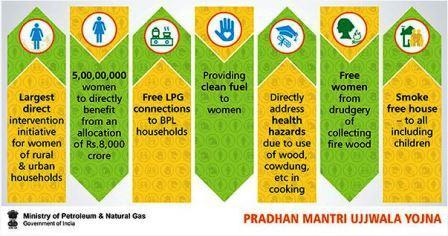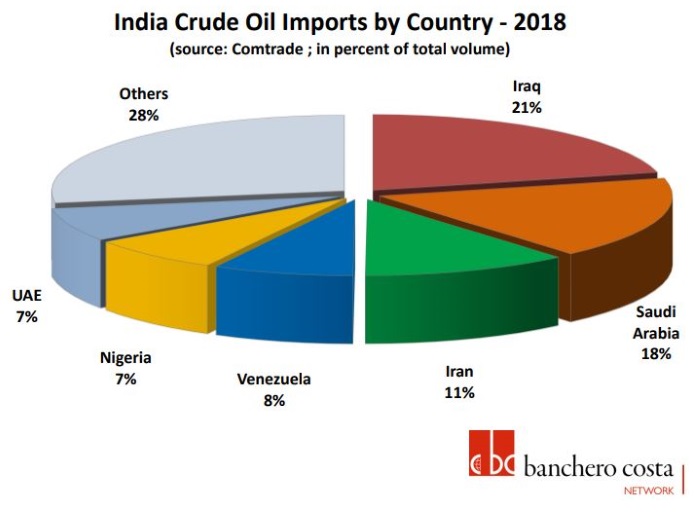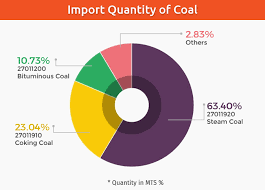Contents:
- Ex-Minister set to join BJP today, likely to file nomination for RS
- LPG scheme PM Ujjwala Yojana closed, but only 3 states have gone kerosene-free
- Oil surges on hope of economic stimulus
- Thermal coal imports for 2019 rise 12.6%
- Shared economy at $2 billion by end-2020
- Gujarat tops in domestic solar rooftop installations
EX-MINISTER SET TO JOIN BJP TODAY, LIKELY TO FILE NOMINATION FOR RS
Focus: GS-II Indian Polity, Governance, Prelims
Why in news?
Over 22 Congress MLAs from Madhya Pradesh had resigned from the Assembly on March 10, bringing the government into a political crisis.
Following the resignation of Congress leader Jyotiraditya Scindia from the party, 13 MLAs and six Ministers owing allegiance to him, sent their resignations.
What is Defection (Aaya Ram Gaya Ram)?
- Aaya Ram Gaya Ram (English: Ram has come, Ram has gone) expression in politics of India means the frequent floor-crossing, turncoating, switching parties and political horse trading in the legislature by the elected politicians and political parties.
- A legislator is deemed to have defected if he either voluntarily gives up the membership of his party or disobeys the directives of the party leadership on a vote. This implies that a legislator defying (abstaining or voting against) the party whip on any issue can lose his membership of the House.
- The law applies to both Parliament and state assemblies.
- The anti-defection law sought to prevent such political defections which may be due to reward of office or other similar considerations.
Anti-Defection Law
- 1985 Anti-defection Act was passed in 1985 to prevent such defections.
- It was included in constitution by Rajiv Gandhi government as the tenth schedule of Indian constitution.
- The Anti-defection Act, applicable to both Parliament and state assemblies, specifies the process for the Presiding Officer of a legislature (Speaker) to disqualify a legislators on grounds of defection based on a petition by any other member of the House.
- Legislators can change their party without the risk of disqualification to merge with or into another party provided that at least two-thirds of the legislators are in favour of the merger, neither the members who decide to merge, nor the ones who stay with the original party will face disqualification.
- The Supreme Court mandated that in the absence of a formal resignation, the giving up of membership can be determined by the conduct of a legislator, such as publicly expressing opposition to their party or support for another party, engaging in anti-party activities, criticizing the party on public forums on multiple occasions, and attending rallies organised by opposition parties.
- The Presiding Officer has no time limit to make his decision
Members of Rajya Sabha
- The Rajya Sabha or the Upper House of Parliament is modeled after the House of Lords in the United Kingdom.
- The Rajya Sabha currently has 245 members, including 233 elected members and 12 nominated.
- As per the constitutional limit, the Upper House strength cannot exceed 250.
- Nominated members of the Rajya Sabha are picked by the President of India.
- These MPs are luminaries from the world of economics, sports, literature, art, social service etc.
- The Vice-President is the chairperson of the Rajya Sabha, which is the final stop before a bill is sent for presidential assent.
Election of Rajya Sabha Members
- Feature of Election of Members in Rajya Sabha is taken from South African constitution.
- Rajya Sabha members are elected indirectly by the people, that is, by the MLAs.
- How many Rajya Sabha members a state can send depends on its population.
- Hence, the number of elected seats too changes as states are merged, bifurcated or new ones are created.
- Every Rajya Sabha MP has a tenure of six years and elections to one-third seats are held every two years.
- According to Section 154 of the Representation of the People Act 1951, a member chosen to fill a casual vacancy will serve for the remainder of his predecessor’s term of office.
- Members of a state’s Legislative Assembly vote in the Rajya Sabha elections in what is called proportional representation with the single transferable vote (STV) system. Each MLA’s vote is counted only once.
- In this system, MLAs don’t vote for each seat. If that were the case, then only ruling party representatives would make it through. Instead, the MLAs are given a paper with the names of all candidates. They have to give their order of preference for each candidate, marking 1,2,3… against their names. If 10 or more members choose a candidate as their first choice, he/she gets elected.
- The political party that has a majority in the state Assembly normally gets to send the maximum number of MPs to the Rajya Sabha.
- The formula is [(Number of MLAs X 100) / (Vacancies + 1)] + 1.
- Simply put, every candidate in the race requires one-fourth of the total number of votes plus one to get elected. Each voter ranks his preferences and if the candidate who is the first choice has enough votes already or no chance of being elected, the vote is transferred to the second choice and so on.
Nomination of Members in Rajya Sabha
- Art.80(1)(a) of Constitution of India makes provision for the nomination of 12 members to the Rajya Sabha by the President of India in accordance with provisions of Arts.80(3).
- Art.80(3) says that the persons to be nominated as members must be possessing special knowledge or practical experience in respect of such matters as the following namely : Literature, science, art and social service.
LPG SCHEME PM UJJWALA YOJANA CLOSED, BUT ONLY 3 STATES HAVE GONE KEROSENE-FREE
Focus :GS-II Social Justice
Why in news?
- A parliamentary committee has said only three States and five Union Territories have become kerosene-free.
- Government in September last met the target of eight crore LPG connections under the Pradhan Mantri Ujjwala Yojana on September 2020.
Details of the report
- The report of the Parliamentary Committee on Petroleum, which was tabled last week, points to the gap between the continuing use of kerosene and the claim of 97% LPG coverage nationwide.
- The committee said that there are poor households in the general category in urban and semi-urban localities that also need to be covered.
- The committee, therefore, recommends that the scheme be extended to poor households in urban and semi-urban slum areas, and achieve a higher LPG coverage of the population by providing connections to households that do not have LPG
- Only three States — Haryana, Punjab and Andhra Pradesh — and the Union Territories of Delhi, Chandigarh, Daman & Diu, Dadar & Nagar Haveli, Andaman & Nicobar Island and Puducherry have become kerosene-free.
Pradhan Mantri Ujjwala Yojana
Pradhan Mantri Ujjwala Yojana (PMUY) was launched by Prime Minister of India Narendra Modi on 1 May 2016 to distribute 50 million LPG connections to women of BPL families.

What was the need for PMUY Scheme?
- In India, the poor have limited access to cooking gas (LPG). The spread of LPG cylinders has been predominantly in the urban and semi-urban areas with the coverage mostly in middle class and affluent households.
- But there are serious health hazards associated with cooking based on fossil fuels. According to WHO estimates, about 5 lakh deaths in India alone due to unclean cooking fuels.
- Most of these premature deaths were due to non-communicable diseases such as heart disease, stroke, chronic obstructive pulmonary disease and lung cancer.
- Indoor air pollution is also responsible for a significant number of acute respiratory illnesses in young children.
- According to experts, having an open fire in the kitchen is like burning 400 cigarettes an hour.
Advantages of PMUY
- Providing LPG connections to BPL households will ensure universal coverage of cooking gas in the country.
- This measure will empower women and protect their health.
- It will reduce drudgery and the time spent on cooking.
- It will also provide employment for rural youth in the supply chain of cooking gas.
OIL SURGES ON HOPE OF ECONOMIC STIMULUS
Focus: GS-III Economic development
Why in news?
Oil prices surged by around 8% on 10th March 2020, a day after the biggest rout in nearly 30 years as investors eyed the possibility of economic stimulus and Russia signalled that talks with OPEC remained possible.
Joint Steps with Russia
- Russian Oil Minister Alexander Novak said he did not rule out joint measures with OPEC to stabilise the market, adding that the next OPEC+ meeting was planned for May-June.
- But in response, Saudi Arabia’s Energy Minister said he did not see a need to hold an OPEC+ meeting in May-June if there was no agreement on what steps should be taken to deal with the impact of the COVID-19 on oil demand and prices.
India and Oil Imports

- India is heavily dependent on crude oil and LNG imports with 82.8% import dependence for crude oil and 45.3% for natural gas/LNG.
- The net foreign exchange outgo is 63.305 billion US$ in the financial year 2017-18 on account of crude oil imports.
- India generated 35.2 million tons of petroleum products from indigenous crude oil production whereas the consumption of petroleum products is 204.9 million tons. Similarly India generated 31.7 bcm natural gas locally against the consumption of 58.1 bcm.
- LNG price is linked to the prevailing crude oil price in global markets.
- India is the third biggest oil importer after US and China in 2018 and expected to occupy second place surpassing the US in 2019.
THERMAL COAL IMPORTS FOR 2019 RISE 12.6%
Focus: GS-III Indian Economy, Industry and Infrastructure
Why in news?
India’s thermal coal imports rose 12.6% to nearly 200 million tonnes in 2019, government data reviewed by Reuters showed, reflecting the second straight year of growth in shipments of the fuel despite attempts by the government to cut imports.
India’s Coal Imports
- Coal is among the top five commodities imported by India, the world’s largest consumer, importer and producer of the fuel.
- India imported 51.33 million tonnes of coking coal in 2019, down from 51.63 million tonnes in 2018, the data showed.

- Imports of thermal coal — mainly used for power generation — jumped 12.6% to 197.84 million tonnes in 2019.
- However, imports of coking coal — used mainly in the manufacturing of steel — fell marginally, following two straight years of increase, government data showed.
- While higher coal imports may be bad news for the Indian government, they benefit international miners.
Types of Coal
As geological processes apply pressure to dead biotic material over time, under suitable conditions, its metamorphic grade or rank increases successively into:
- Peat, a precursor of coal
- Lignite, or brown coal, the lowest rank of coal, most harmful to health, used almost exclusively as fuel for electric power generation
- Jet, a compact form of lignite, sometimes polished; used as an ornamental stone since the Upper Palaeolithic
- Sub-bituminous coal, whose properties range between those of lignite and those of bituminous coal, is used primarily as fuel for steam-electric power generation.
- Bituminous coal, a dense sedimentary rock, usually black, but sometimes dark brown, often with well-defined bands of bright and dull material. It is used primarily as fuel in steam-electric power generation and to make coke.
- Anthracite, the highest rank of coal is a harder, glossy black coal used primarily for residential and commercial space heating.
- Graphite is difficult to ignite and not commonly used as fuel; it is most used in pencils, or powdered for lubrication.
- Cannel coal (sometimes called “candle coal”) is a variety of fine-grained, high-rank coal with significant hydrogen content, which consists primarily of liptinite.
- There are several international standards for coal.
- The classification of coal is generally based on the content of volatiles. However the most important distinction is between thermal coal (also known as steam coal), which is burnt to generate electricity via steam; and metallurgical coal (also known as coking coal), which is burnt at high temperature to make steel.
SHARED ECONOMY AT $2 BILLION BY END-2020
Focus: GS-III Indian Economy
Why in news?
The shared economy in India is estimated to be an about $2 billion industry by the end of the current 2020 year, according to a recent report by Maple Capital Advisors.
What is Shared Economy?
- The sharing economy is a way of distributing goods and services that differs from the traditional model of corporations hiring employees and selling products to consumers.
- In the sharing economy, individuals are said to rent or “share” things like their cars, homes and personal time to other individuals in a peer-to-peer fashion.
- The ‘shared economy’ includes segments such as co-working (Awfis, WeWork India), co-living (Stanza Living, OYO Life, Oxford Caps), shared mobility (Uber, Ola, Shuttl) and furniture rental (Furlenco, Rentomojo.)
- India mirrors Asia trends in these aspects and is thus poised for high growth and adoption of shared services.
Significance of Shared Economy in India
- India is at the cusp of a shared economy revolution. We are already witnessing phenomenal growth in this segment with both international companies and home-grown start-ups vying for market share.
- Even as the space is nascent, over $3.7 bn has been invested in this space and we expect this to accelerate from here, on the back of compelling demand and unit economics.
- In this era of growing concern on climate, wastage, resource scarcity and population intensity (especially in the developing world), the shared economy seems to be a sustainable, scalable and efficient form of addressing these concerns.
GUJARAT TOPS IN DOMESTIC SOLAR ROOFTOP INSTALLATIONS
Focus: GS-III Environment and Ecology
Why in news?
Gujarat has topped the list in the installations of solar rooftop plants across the country with about 50,915 systems being fixed on domestic rooftops in the State as on March 2, 2020.
Solar Power Generation in India’s States
1. Karnataka
Karnataka tops the list of states with the highest installed solar power generation capacity in the country. The state’s total solar capacity at the end of 2018 stood at 5,328 megawatt (MW). While, its total installed electricity generation capacity stood at 27,199 MW at the end of 2018, with solar sector’s share at 19.58 per cent.
2. Telangana
Telangana houses the second-highest installed solar power generation capacity in the country. The state’s solar capacity at the end of 2018 stood at 3,501 MW. Its total installed electricity generation capacity stood at 15,944 MW at the end of 2018, with solar sector’s share at 22 per cent.
3. Rajasthan
Rajasthan houses the third-highest installed solar power generation capacity in the country. The state’s solar capacity at the end of 2018 stood at 3,081 MW. Rajasthan’s total installed electricity generation capacity stood at 21,833 MW at the end of 2018, with solar sector’s share at 14.11 per cent.
4. Andhra Pradesh
Andhra Pradesh houses the fourth-highest installed solar power generation capacity in the country. The state’s solar capacity at the end of 2018 stood at 2,829 MW. Andhra Pradesh’s total installed electricity generation capacity stood at 23,726 MW at the end of 2018, with solar sector’s share at 12 per cent.
5. Tamil Nadu
Tamil Nadu houses the fifth-highest installed solar power generation capacity in the country. The state’s solar capacity at the end of 2018 stood at 2,055 MW. Tamil Nadu’s total installed electricity generation capacity stood 30,447 MW at the end of 2018, with solar sector’s share at 6.74 per cent.
6. Gujarat
Gujarat houses the sixth- largest installed solar power generation capacity in the country. The state’s solar capacity at the end of 2018 stood at 1,607 MW. Gujarat’s total installed electricity generation capacity stood at 31,382 MW at the end of 2018, with the solar sector’s share at 5.12 per cent.
7. Madhya Pradesh
Madhya Pradesh houses the seventh-largest installed solar power generation capacity in the country. The state’s solar capacity at the end of 2018 stood at 1,526 MW. Madhya Pradesh’s total installed electricity generation capacity stood at 21,873 MW at the end of 2018, with the solar sector’s share at 7 per cent.
8. Maharashtra
Maharashtra houses the eighth-largest installed solar power generation capacity in the country. The state’s solar capacity at the end of 2018 stood at 1,311 MW. Its total installed electricity generation capacity stood at 43,779 MW at the end of 2018, with the solar sector’s share at 3 per cent.
9. Uttar Pradesh
Uttar Pradesh houses the ninth-largest installed solar power generation capacity in the country. The state’s solar capacity at the end of 2018 stood at 875 MW. Madhya Pradesh’s total installed electricity generation capacity stood at 25,061 MW at the end of 2018, with the solar sector’s share at 3.49 per cent.
10. Punjab
Punjab houses the 10th-largest installed solar power generation capacity in the country. The state’s solar capacity at the end of 2018 stood at 845 MW. Punjab’s total installed electricity generation capacity stood at 13,432 MW at the end of 2018, with the solar sector’s share at 6.29 per cent.



